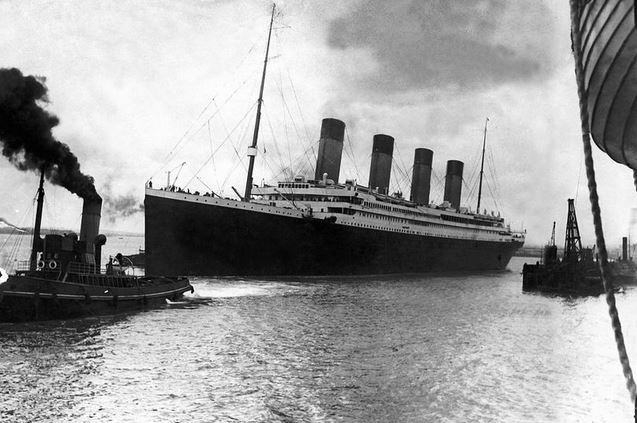It was hours after the Titanic sank beneath the ocean. As rescuers did one last sweep with their flashlight in the cold dark water, they spotted a young man desperately holding on to a floating wooden door.
Just 17 at the time, Lang was one of eight third-class Chinese passengers aboard the luxury steamship when it hit an iceberg halfway through its trip to New York in the early hours of April 15, 1912.
The stories of the Titanic’s richest passengers, like Molly Brown and John Jacob Astor, one of the wealthiest men in the world at the time, fill history books and fascinate film fans, the stories of the ship’s other travelers seem to have been lost throughout history.
Ah Lam, Fang Lang, Len Lam, Cheong Foo, Chang Chip, Ling Hee, Lee Bing and Lee Ling – mariners believed to have been heading to the Caribbean for work – were crammed with other third-class passengers in steerage, in the bowels of the huge liner.
Two of the Chinese men drowned, but five of the others managed to make their way on lifeboats. The sixth man, Fang, grabbed onto debris in the water. He was moments from freezing to death when he was rescued by one of the lifeboats that turned back to look for survivors.
The way the teenager was discovered, hanging on to a floating door in the water, is actually what inspired the famous scene from the 1997 Hollywood blockbuster Titanic.
Director James Cameron ended up cutting the original character that was based on Fang, but he still used his rescue to inspire the tragic moment Leonardo DiCaprio’s Jack sacrifices himself so that Kate Winslet’s Rose can survive.
But now, a new documentary has traced what happened to Fang and the other Chinese survivors. It also reveals how rather than being honored for surviving such a tragedy, once they were back on land they were vilified and expelled from the United States, and later Britian too.
The documentary, called The Six, has just premiered in China. It also tracked down descendants of other survivors, some of whom were not aware their relatives were even abord the ship because they never spoke about it.
The names of the eight Chinese passengers can be found a single third-class ticket, suggesting all the men knew each other and boarded the ship together.
British film-maker Arthur Jones, along with American historian Steven Schwankert, discovered the men, who were between the ages of 18 and 37. They were headed for Cuba and had been scheduled to board the Annetta, a freighter, in New York once the Titanic docked.
“The reason they were travelling on the Titanic in the first place is for work. They were professional mariners,” Steven said.
Some believe that the Chinese sailors were able to survive because they didn’t understand instructions to stay in their rooms, so they were able to escape to lifeboats.
But unlike other Titanic survivors, the six men were persecuted when they arrived safely in New York due to a strong anti-Chinese sentiment in the West in the early 20th century.
They were also falsely accused of saving their own lives ahead of women and children by hiding in the lifeboats.
However, according to records, the men actually tried to help other survivors. After being pulled from the waters, Fang Lang later rowed the lifeboat that rescued him and helped ferry everyone on board to safety.
Little more was known of the men until Jones and Schwankert started their research.
They discovered that within 24 hours of their arrival at the immigration inspection station on New York’s Ellis Island, the men were expelled from the country because of the Chinese Exclusion Act, which barred the immigration of Chinese people to the US.
“They were not treated humanely. We know they lost close friends on board. Not only did they have to leave in 24 hours, they were held overnight in custody,” Arthur says.
They were forced to travel to the Caribbean to work on fruit ships before heading to the UK due to a shortage of sailors caused by men fighting in the First World War.
Fang Lang sailed between Britain and Hong Kong for years before becoming a U.S. citizen.
The filmmakers tracked down his American-Chinese son, Tom Fong, who was born in Milwaukee, Wisconsin, almost half a century after the Titanic sinking.
The 59-year-old revealed throughout his childhood his relatives had hinted his father had survived a shipwreck but that he had never spoken about it or even his mother Marie, who is now 86.
Fang was 65 when Tom was born. He died in 1985 aged 90.
Tom only learned his dad survived the Titanic when a family member mentioned it 20 years after his death.
“I asked my mother. She’d never heard about my father being on this boat and it sinking,” he said.
He thinks his father kept it secret because of the trauma and persecution.
Researchers later found out that Fang wrote to his relatives on Xiachuan, an island in the South China Sea, about the accident, and that one person there has a poem Fang wrote detailing his struggle to stay afloat in the frigid ocean as others cried for help in the darkness around him.
But Tom, who owns a restaurant, hasn’t told anyone about his father until now – for fear people wouldn’t believe him.
“It’s crazy. I never really told anybody. I was afraid to. It’d be like telling someone you were inside of a UFO or had seen aliens. They’d think you were crazy,” he said.


Wow………what an awesome story.
In the education system of this USA , for over about 200 years they forgot to teach that everyone except white persons were prohibited from coming to this New Country as free persons. They brought the Chinese here to build the rail road and they were in a lot of cases actually taken into the desert and executed, instead of being sent back home, and the Chinese mob who actually controlled the Chinese workers did the execution but it was known by the USA Government that it happened.